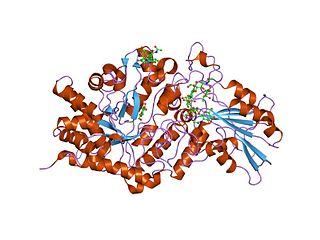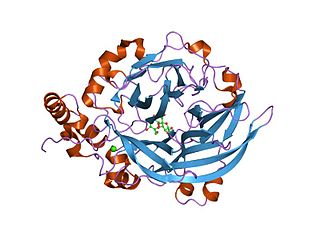
Glycoside hydrolase family 1 is a family of glycoside hydrolases. Glycoside hydrolases EC 3.2.1. are a widespread group of enzymes that hydrolyse the glycosidic bond between two or more carbohydrates, or between a carbohydrate and a non-carbohydrate moiety. A classification system for glycoside hydrolases, based on sequence similarity, has led to the definition of >100 different families. This classification is available on the CAZy web site, and also discussed at CAZypedia, an online encyclopedia of carbohydrate active enzymes.

In molecular biology, Glycoside hydrolase family 10 is a family of glycoside hydrolases.

In molecular biology, Glycoside hydrolase family 11 is a family of glycoside hydrolases.

In molecular biology, Glycoside hydrolase family 12 is a family of glycoside hydrolases.

In molecular biology, Glycoside hydrolase family 17 is a family of glycoside hydrolases. It folds into a TIM barrel.

In molecular biology, glycoside hydrolase family 3 is a family of glycoside hydrolases. Glycoside hydrolases EC 3.2.1. are a widespread group of enzymes that hydrolyse the glycosidic bond between two or more carbohydrates, or between a carbohydrate and a non-carbohydrate moiety. A classification system for glycoside hydrolases, based on sequence similarity, has led to the definition of over 100 different families. This classification is available on the CAZy web site, and also discussed at CAZypedia, an online encyclopedia of carbohydrate active enzymes.

In molecular biology, glycoside hydrolase family 35 is a family of glycoside hydrolases.

In molecular biology, glycoside hydrolase family 46 is a family of glycoside hydrolases.

In molecular biology, glycoside hydrolase family 49 is a family of glycoside hydrolases.

In molecular biology, the glycoside hydrolase family 53 is a family of glycoside hydrolases EC 3.2.1., which are a widespread group of enzymes that hydrolyse the glycosidic bond between two or more carbohydrates, or between a carbohydrate and a non-carbohydrate moiety. A classification system for glycoside hydrolases, based on sequence similarity, has led to the definition of >100 different families. This classification is available on the CAZy web site, and also discussed at CAZypedia, an online encyclopedia of carbohydrate active enzymes.
In molecular biology, glycoside hydrolase family 62 is a family of glycoside hydrolases.

In molecular biology, glycoside hydrolase family 68 is a family of glycoside hydrolases.
In molecular biology, glycoside hydrolase family 76 is a family of glycoside hydrolases.
In molecular biology, glycoside hydrolase family 9 is a family of glycoside hydrolases.
In molecular biology, glycoside hydrolase family 5 is a family of glycoside hydrolases EC 3.2.1., which are a widespread group of enzymes that hydrolyse the glycosidic bond between two or more carbohydrates, or between a carbohydrate and a non-carbohydrate moiety. A classification system for glycoside hydrolases, based on sequence similarity, has led to the definition of >100 different families. This classification is available on the CAZy web site, and also discussed at CAZypedia, an online encyclopedia of carbohydrate active enzymes.
In molecular biology, glycoside hydrolase family 8 is a family of glycoside hydrolases EC 3.2.1., which are a widespread group of enzymes that hydrolyse the glycosidic bond between two or more carbohydrates, or between a carbohydrate and a non-carbohydrate moiety. A classification system for glycoside hydrolases, based on sequence similarity, has led to the definition of >100 different families. This classification is available on the CAZy website, and also discussed at CAZypedia, an online encyclopedia of carbohydrate-active enzymes.

In molecular biology, glycoside hydrolase family 13 is a family of glycoside hydrolases.
In molecular biology, glycoside hydrolase family 15 is a family of glycoside hydrolases.
In molecular biology, glycoside hydrolase family 26 is a family of glycoside hydrolases.
In molecular biology, glycoside hydrolase family 75 is a family of glycoside hydrolases.












